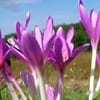Life Span
Perennial
Annual and Perennial
Type
Bulb or Corm or Tuber
Tender Perennial
Origin
Mediterranean, Turkey
South Africa
Types
Not available
Osteospermum acanthospermum, Osteospermum amplectens, Osteospermum burttianum
Number of Varieties
Not Available
Habitat
Lawn, meadows, Sunny Edge, Woodland Garden
Coastal Regions, Sandy areas, Terrestrial
USDA Hardiness Zone
6-9
10-11
AHS Heat Zone
9-1
Not Available
Sunset Zone
21,22
8, 9, 12, 13, 14, 15, 16, 17, 18, 19, 20, 21, 22, 23, 24
Habit
Clump-Forming
Clump-Forming
Flower Color
Fuchsia, Rose
White, Purple, Blue Violet
Flower Color Modifier
Bicolor
Bicolor
Fruit Color
Not Available
Not Available
Leaf Color in Spring
Green
Green
Leaf Color in Summer
Light Green
Green
Leaf Color in Fall
Several shades of Green
Green, Blue Green
Leaf Color in Winter
Light Green
Light Green
Leaf Shape
Long Broad
Irregular
Plant Season
Spring, Fall
Spring, Summer, Fall
Sunlight
Full Sun, Partial Sun
Full Sun, Partial Sun
The pH of Soil
Acidic, Neutral
Neutral
Soil Drainage
Well drained
Well drained
Bloom Time
Late Summer, Early Fall
Late Spring, Early Summer, Summer, Late Summer, Early Fall, Fall
Tolerances
Drought
Drought
Where to Plant?
Container, Ground, Pot
Container
How to Plant?
Corms or bulbs, Seedlings
Seedlings, Stem Cutting
Plant Maintenance
Low
Medium
Watering Requirements
Do Not over Water, Keep the ground moist but not water-logged
Do Not over Water, Keep ground moist
In Summer
Lots of watering
Lots of watering
In Spring
Moderate
Moderate
In Winter
Average Water
Average Water
Soil pH
Acidic, Neutral
Neutral
Soil Drainage Capacity
Well drained
Well drained
Sun Exposure
Full Sun, Partial Sun
Full Sun, Partial Sun
Pruning
Cut or pinch the stems, Remove damaged leaves, Remove dead flowers, Remove dead leaves
Remove damaged leaves, Remove dead branches, Remove dead leaves
Fertilizers
All-Purpose Liquid Fertilizer, fertilize in summer
All-Purpose Liquid Fertilizer
Pests and Diseases
Slugs
Red blotch
Plant Tolerance
Drought
Drought
Flower Petal Number
Single
Single
Foliage Texture
Coarse
Medium
Foliage Sheen
Not Available
Not Available
Attracts
Bees, Butterflies
Bees, Birds, Butterflies
Allergy
poisonous if ingested, Toxic if not prepared properly
Not Available
Aesthetic Uses
Beautification, Cottage Garden, Showy Purposes
Beautification, Showy Purposes
Beauty Benefits
Removes pimples
Not Available
Environmental Uses
Air purification
Air purification
Medicinal Uses
Arthritis, Gout, Itching
Not Applicable
Part of Plant Used
Bulbs, Flowers, Seeds
Flowers
Other Uses
Used as Ornamental plant, Used for its medicinal properties
Used as Ornamental plant
Used As Indoor Plant
No
No
Used As Outdoor Plant
Yes
Yes
Garden Design
Alpine, Container, Mixed Border, Rock Garden / Wall
Bedding Plant, Container, Cutflower, Foundation, Groundcover, Hanging Basket, Mixed Border, Rock Garden / Wall
Botanical Name
Colchicum autumnale
OSTEOSPERMUM fruticosum
Common Name
Autumn Crocus, meadow saffron, naked lady
Shrubby Daisybush, Trailing African Daisy
In Hindi
शरद ऋतु का पौधा
Blue Eyed Daisy Plant
In German
Herbstzeitlose
Blue Eyed Daisy Pflanze
In French
colchique d'automne
Blue Eyed Daisy Plante
In Spanish
cólquico
Planta observada azul de la margarita
In Greek
φθινόπωρο κρόκος
Μπλε Eyed Daisy Φυτών
In Portuguese
aftomn gema
Planta da margarida de olhos azuis
In Polish
aftomn żółtka
Blue Eyed Daisy roślin
In Latin
aftomn vitellus
Daisy Blue Eyed Planta
Phylum
Magnoliophyta
Magnoliophyta
Class
Liliopsida
Magnoliopsida
Family
Liliaceae
Asteraceae
Genus
Colchicum
Osteospermum
Clade
Angiosperms, Monocots
Angiosperms, Asterids, Eudicots
Tribe
Colchiceae
Calenduleae
Subfamily
Not Available
Asteroideae
Properties of Autumn Crocus and Blue Eyed Daisy Plant
Wondering what are the properties of Autumn Crocus and Blue Eyed Daisy Plant? We provide you with everything About Autumn Crocus and Blue Eyed Daisy Plant. Autumn Crocus doesn't have thorns and Blue Eyed Daisy Plant doesn't have thorns. Also Autumn Crocus does not have fragrant flowers. Autumn Crocus has allergic reactions like poisonous if ingested and Toxic if not prepared properly and Blue Eyed Daisy Plant has allergic reactions like poisonous if ingested and Toxic if not prepared properly. Compare all the properties and characteristics of these two plants. Find out which of these plant can be used as indoor plant. If you are interested to decorate your house and garden, find out aesthetic uses, compare them and select the plant which will beautify your surrounding. Along with beautification, try comparing medicinal and edible uses of Autumn Crocus and Blue Eyed Daisy Plant and you can choose the plant having best and most benefits.
Season and Care of Autumn Crocus and Blue Eyed Daisy Plant
Season and care of Autumn Crocus and Blue Eyed Daisy Plant is important to know. While considering everything about Autumn Crocus and Blue Eyed Daisy Plant Care, growing season is an essential factor. Autumn Crocus season is Spring and Fall and Blue Eyed Daisy Plant season is Spring and Fall. The type of soil for Autumn Crocus is Loam and for Blue Eyed Daisy Plant is Loam while the PH of soil for Autumn Crocus is Acidic, Neutral and for Blue Eyed Daisy Plant is Neutral.
Autumn Crocus and Blue Eyed Daisy Plant Physical Information
Autumn Crocus and Blue Eyed Daisy Plant physical information is very important for comparison. Autumn Crocus height is 7.60 cm and width 7.60 cm whereas Blue Eyed Daisy Plant height is 36.00 cm and width 51.00 cm. The color specification of Autumn Crocus and Blue Eyed Daisy Plant are as follows:
Autumn Crocus flower color: Fuchsia and Rose
Autumn Crocus leaf color: Green
Blue Eyed Daisy Plant flower color: White, Purple and Blue Violet
- Blue Eyed Daisy Plant leaf color: Green
Care of Autumn Crocus and Blue Eyed Daisy Plant
Care of Autumn Crocus and Blue Eyed Daisy Plant include pruning, fertilizers, watering etc. Autumn Crocus pruning is done Cut or pinch the stems, Remove damaged leaves, Remove dead flowers and Remove dead leaves and Blue Eyed Daisy Plant pruning is done Remove damaged leaves, Remove dead branches and Remove dead leaves. In summer Autumn Crocus needs Lots of watering and in winter, it needs Average Water. Whereas, in summer Blue Eyed Daisy Plant needs Lots of watering and in winter, it needs Average Water.





